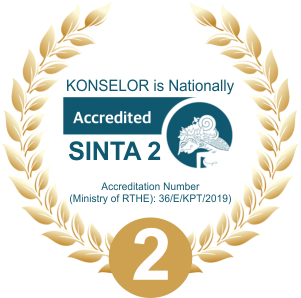Pathological internet use in adolescents
 ), Murat Coşkun(2),
), Murat Coşkun(2), (1) Istanbul prof.Dr. Cemil Taşcıoğlu city hospital
(2) Istanbul University Faculty of Medicine, The Department of Child and Adolescent Psychiatry, Turkey
 Corresponding Author
Corresponding Author
Copyright (c) 2021 Hüseyi̇n Dağ, Murat Coşkun
DOI : https://doi.org/10.24036/02021101111988-0-00
Full Text:
 Language : en
Language : en
Abstract
Internet addiction, which is one of the handicaps seen as a result of modern lifestyle and technological development, can be defined as the inability to prevent the desire to use the internet excessively and the need for more and more time spent on the internet. Rather than banning the internet entirely, controlling its use is a more appropriate option. As in all addictions, when the problem cannot be solved, it is important to benefit from medical and cognitive therapies and, when appropriate, child and adolescent mental health counseling.
References
Anderson, EL., Steen, E., Stavropoulos, V. (2017). Internet use and Problematic Internet Use: a systematic review of longitudinal research trends in adolescence and emergent adulthood. Int J Adolesc Youth, 22, 430–54.
Andreou E, Svoli H (2013). The association between internet user characteristics and dimensions of internet addiction among Greek adolescents. Int J Ment Health Addict 11(2):139–148.
Beard, KW. (2005). Internet addiction: a review of current assessment techniques and potential assessment questions. Cyberpsychol Behav 8, 7-14.
Bozkurt, H., Coskun, M., Ayaydin, H., Adak I., Zoroglu, SS. (2013) Prevalence and patterns of psychiatric disorders in referred adolescents with Internet addiction. Psychiatry Clin Neurosci. 67, 352-359.
Bozkurt, H., Şahin,S., Zoroğlu, S. (2016). İnternet Bağımlılığı. Güncel Bir Gözden Geçirme. Çağdaş Tıp Dergisi 6(3); 235-247
Davis, RA. (2001). A cognitive-behavioral model of pathological Internet use (PIU). Computers in Human Behavior. 17, 187-195.
Dell’ Osso, B., Altamura, AC., Hadley, SJ., Baker, BR., Hollander, E. (2007). An open label trial of escitalopram in the treatment of impulsive-compulsive Internet usage disorder. European Neuropsychopharmacology. 16, 82-83.
Goldberg I. (1999). Internet Addiction Disorder. Available at www.cog.brown.edu/brochure/people/ duchonf/humor/internetaddiction.html.
Griffiths, MD. (1996). Internet addiction: An issue for psychopathology? Clinical Psychology Forum 97, 32- 36.
https://www.internetlivestats.com/internet-users-by-country/2015/( accessed 03 march 2021)
Kofler, MJ., Rapport, MD., Bolden, J., Sarver, DE., Raiker, JS., Alderson, RM (2011) Working memory deficits and social problems in children with ADHD. J Abnorm Child Psychol 39(6):805–817.
Koyama, A., Miyake, Y., Kawakami, N., Tsuchiya, M., Tachimori, H., Takeshima, T. (2010). Lifetime prevalence, psychiatric comorbidity and demographic correlates of “hikikomori” in a community population in Japan. Psychiatry research 176, 69-74.
Morse, RM., Flavin, DK. (1992) The definition of alcoholism. JAMA 268(8):1012–1014.
Sasmaz, T., Oner, S., Kurt, AO., Yapici G., Yazici, AE., Bugdayci, R., Sis, M. (2014). Prevalence and risk factors of Internet addiction in high school students. Eur J Pub Health 24(1):15–20.
Skounti, M., Giannoukas, S., Dimitriou, E., Nikolopoulou, S., Linardakis, E., Philalithis, A. (2010) Prevalence of attention deficit hyperactivity disorder in schoolchildren in Athens, Greece. Association of ADHD subtypes with social and academic impairment. ADHD Atten Deficit Hyperact Disord 2(3):127–132.
Spada, MM. (2014). An overview of problematic internet use. Addict Behav. 39, 3–6.
Tahiroglu, AY., Celik, GG., (2010). Psikiyatrik Bozukluğu Olan ve Olmayan Ergenlerde Problemli İnternet Kullanımı. Nöropsikiyatri Arşivi. 47, 241-246.
Young, KS. (1996). Internet addiction: The emergence of a new clinical disorder. Cyberpsychol Behav. 3, 237-244.
Young, KS. (2004). Internet addiction. Am Behav Sci, 48, 402-441.
 Article Metrics
Article Metrics
 Abstract Views : 565 times
Abstract Views : 565 times
 PDF Downloaded : 89 times
PDF Downloaded : 89 times
Refbacks
- There are currently no refbacks.
Copyright (c) 2021 Hüseyi̇n Dağ, Murat Coşkun

This work is licensed under a Creative Commons Attribution 4.0 International License.







